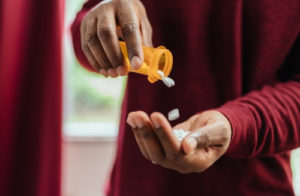Every day, thousands of people experience the kind of terror that ensnares and smothers and can last for as long as 10 minutes per episode, occurring at least once a month or week.
There are others, millions of them, whose hearts race, palms sweat, and hands shake at the sight of a stranger or the thought of a jarring memory, and still others who believe they are dying or on the verge of succumbing to death, with no perceptible stimuli to provoke their feelings. It just is.
Add to that the violence, poverty, unrest, and overall turbulence of contemporary life that reinforces the fear and anxiety.
The prevalence of these disorders is why anxiety meds like Xanax continue to be among the best-selling prescription medications every year. Science News points out that the number of U.S. adults who have filled out prescriptions for benzodiazepines like Xanax jumped by 67 percent between 1996 (8.1 million) and 2013 (13.5 million).
In fact, people who have not experienced some form of anxiety disorder are beginning to be viewed as the anomaly instead of the norm.
Said one woman in a New York Times article, “Prozac Nation Is Now the United States of Xanax,” If you’re a human being living in 2017 and you’re not anxious, there’s something wrong with you.”
While Xanax use has become emblematic of our times, many users are lapsing into abuse and addiction accidentally or intentionally. This puts them at risk of experiencing dangerous effects, symptoms, and even death.
The History and Cultural Imprint of Xanax

Alprazolam, the generic name for Xanax, was first developed in the late 1960s as a sleep aid that also acted as a muscle relaxer, according to Drugs.com.
Soon, researchers would discover that alprazolam would be effective in treating anxiety and panic disorder. Then, in 1981, the U.S. Food and Drug Administration (FDA) approved Xanax for those conditions.
The timing was fortuitous because the third edition of the Diagnostic and Statistical Manual of Mental Disorders (DSM-III), published by the American Psychiatric Association in 1980, included anxiety disorders as a clinical category. What’s more, Xanax arrived just before the patent on the widely known benzo Valium was set to expire.
Picking Up Where Valium Left Off
Yet, what differentiated Xanax from Valium is that the FDA approved it to treat panic disorder, which was introduced as a new treatment category at that time. By 1986, that helped propel Xanax to become the best-selling drug in history, overtaking Miltown, Librium, and Valium in the process.
Just as Valium would become a cultural touchstone for the 1960s and 1970s, enshrined in song by The Rolling Stones and chronicled in movies by Woody Allen, Xanax would also help define the zeitgeist or the spirit of our modern times as an antidote for the unrest and disruption that have come to embody this age.
As one writer posited in The New York Times, “Anxiety has become our everyday argot, our thrumming lifeblood…anxiety is starting to seem like a sociological condition, too: a shared cultural experience that feeds on alarmist CNN graphics and metastasizes through social media.”
In fact, the Anxiety and Depression Association of America estimates that anxiety disorders affect 40 million people in the United States, age 18 and older, every year. The panic attacks associated with anxiety disorders afflict six million adults, as well.
Whether encountered through a prescription or recreationally, people have sought out Xanax as a sort of refuge.
One writer noted in the Washington Post that because of this age, popular music has shaped the dreamlike, sedative effects of Xanax — an escape for disrupted listeners.
“…in today’s freaked-out America — where relief-seekers are swallowing opioids and benzodiazepines in record numbers — the connection between our sounds and our substances feels pervasive…Brand names keep popping up in our singalongs, particularly in rap music, where Xanax, Percocet, and other pharmaceuticals have long been praised for their abilities to numb the agony of existence. ”
Dosing Information
Xanax, which is part of a class of benzodiazepines, works by mimicking gamma-Aminobutyric acid (GABA), a neurotransmitter that regulates feelings of anxiety by blocking the nerve signals from being able to reach the brain. Activating GABA, Xanax presses it into overproduction, which ultimately depresses the central nervous system (CNS). What results are palpable feelings of relaxation and calm.
Xanax and generic alprazolam come as a tablet. Xanax also is available as an extended-release tablet and as orally disintegrating tablets. It also comes as a concentrated solution.
Either way, the Xanax tablet, the orally disintegrating medicine, and solution are only intended to be taken two to four times a day, while the extended-release version is to be ingested only once a day, typically in the morning.
Dangers of Xanax
Benzodiazepines like Xanax are generally intended for short-term use only. When larger than normal doses of it is ingested, or it is taken for long periods against a doctor’s advice, tolerance, dependence, and addiction can occur.
When Xanax is abused, it can impact the body like alcohol where users will be physically and cognitively impaired. They will also exhibit drowsiness, dizziness, slurred speech, and lethargy and have trouble driving or operating machinery.
But the effects they produce can be more harmful.
Signs of Xanax Addiction
When Xanax is abused for a long time, a user will feel normal only when the drug is present in their bodies. This is when drug dependence is established. When someone abruptly stops using, they will experience painful and uncomfortable benzodiazepine withdrawal symptoms such as:
- Seizures
- Headache
- Psychosis
- Delirium
- Hypotension
- Memory loss
- Hallucinations
- Rebound insomnia
- Rebound anxiety
- Increased sensitivity to light
- Blurred vision
- Nervousness
- Depression
- Muscle twitching
- Vomiting
- Diarrhea
- Tremors
- Pain
- Numbness
- Burning
- Weight loss
- Loss of appetite
That dependence can quickly decline into an addiction where a user begins to prioritize seeking Xanax over virtually everything else in their life. The following behavioral signs of addiction apply to substance use disorders in general:
- Taking Xanax more often or at a higher dose than prescribed
- Forging prescriptions to get more Xanax
- “Doctor shopping” to get more prescriptions for Xanax
- Attempting to justify Xanax abuse
- Needing to take Xanax to perform basic daily functions
- Lack of personal hygiene
- Using Xanax in ways it was not intended (crushing, snorting, etc.)
- Loss of interest in previously enjoyed hobbies and activities
- Lying about or hiding Xanax abuse
- A noticeable decline in performance at work or in school
- Legal or financial difficulties resulting from Xanax abuse
- Being unable to stop taking Xanax despite wanting to
When Xanax Abuse Becomes Deadly
When Xanax abuse occurs, more than likely it is in combination with alcohol, stimulants, and opioids. This kind of polysubstance abuse makes Xanax extremely dangerous, inflicting permanent damage and even death.
People will consume Xanax with alcohol because of the synergistic effects both substances produce. What this means is that both substances build off of each other and their respective effects become heightened. Nevertheless, taking Xanax with alcohol can increase the likelihood of overdose where a person can experience severe sedation, slowed breathing, depression, hypotension, fainting, muscle weakness, and coma.
This is also the case when benzodiazepines are ingested with opioids, which are commonly prescribed together.
Other Signs of Xanax Overdose
- Confusion
- Slurred speech
- Slowed reflexes
- Irregular heartbeat
- Uncontrolled muscle movements and tremors
- Chest pains
- Difficulty breathing
- Hallucinations
- Inability to remain awake
- Coma
Why Professional Treatment is Necessary

Statistical evidence asserts that a Xanax addiction can prove fatal. Overdose deaths resulting from benzodiazepines have seen a more than an eightfold increase from 2000 (1,298 deaths) to 2016 (10,684 deaths).
What’s more, benzodiazepine withdrawal symptoms can be life-threatening, particularly when someone attempts to quit Xanax on his or her own.
If you suspect that you or a loved one has begun to abuse Xanax or are in the throes of full-blown addiction, then professional addiction treatment — instead of quitting “cold turkey” — is absolutely vital.
This is especially the case if Xanax is being abused with alcohol, stimulants, or opioids, as your life is at stake.
A professional program will give you or your loved one access to specialized, comprehensive, and evidence-based treatment.
The first step in this process is known as acute treatment, where the Xanax and other substances are removed from your body. What’s more, medications may be administered to treat other conditions that arise during withdrawal or post-withdrawal, such as anticonvulsants, antidepressants, or melatonin.
After this acute treatment period, you will be enrolled in clinical stabilization services or partial care where you will receive therapy through an array of services, which include:
Holistic Treatments
- Meditation
- Nutritional assessments
- Yoga
Group Therapy
- Emotional regulation
- Medical education
- Motivational enhancement
- Relapse prevention
- The 12 steps of recovery
- Wellness skills
Individual Therapy
- Cognitive behavioral therapy (CBT)
- Dialectical behavior therapy (DBT)
- Genetic testing
- Family-focused therapy
- Trauma-informed sessions
In cases of polysubstance abuse, it is recommended that you enroll in a clinical stabilization program, which offers intensive therapy and counseling structured to address the roots of abuse and addiction.
Additionally, an appointed caseworker will connect you to a recovery community after treatment ends. A community of other people recovering from benzodiazepine addictions provides support and a hedge against relapse and re-addiction.
Get Help Today
You do not have to be trapped into addiction by your Xanax habit. We can offer treatment options that can free you from the grips of Xanax.
Call 855-956-4940 anytime, day or evening, for a free consultation with one of our knowledgeable addiction recovery specialists. They can help you locate the right treatment option. Call us at 855-956-4940 or contact us online for more information.
Alprazolam: MedlinePlus Drug Information. (n.d.). Retrieved from: https://medlineplus.gov/druginfo/meds/a684001.html
Cunningham, A. (2019, February 06). Overdose deaths tied to antianxiety drugs like Xanax and Valium continue to rise. Retrieved from: https://www.sciencenews.org/article/overdose-deaths-tied-antianxiety-drugs-xanax-continue-rise
Facts & Statistics. (n.d.). Retrieved from: https://adaa.org/about-adaa/press-room/facts-statistics
Ggalliani. (2019, February 18). Xanax Addiction and Treatment Guide | Delphi Behavioral Health Group. Retrieved from: https://delphihealthgroup.com/xanax/
Richards, C. (2017, April 20). Soft, smooth and steady: How Xanax turned American music into pill-pop. Retrieved from: https://www.washingtonpost.com/lifestyle/style/soft-smooth-and-steady-how-xanax-turned-american-music-into-pill-pop/2017/04/19/535a44de-1955-11e7-bcc2-7d1a0973e7b2_story.html?utm_term=.8d6a63125b3e
Stats on Panic Disorder. (n.d.). Retrieved from: https://www.psychologytoday.com/us/articles/199307/stats-panic-disorder
(2017, June 10). Prozac Nation Is Now the United States of Xanax. Retrieved from: https://www.nytimes.com/2017/06/10/style/anxiety-is-the-new-depression-xanax.html
Xanax: 12 Things You Should Know. (n.d.). Retrieved from: https://www.drugs.com/slideshow/xanax-faqs-1148


